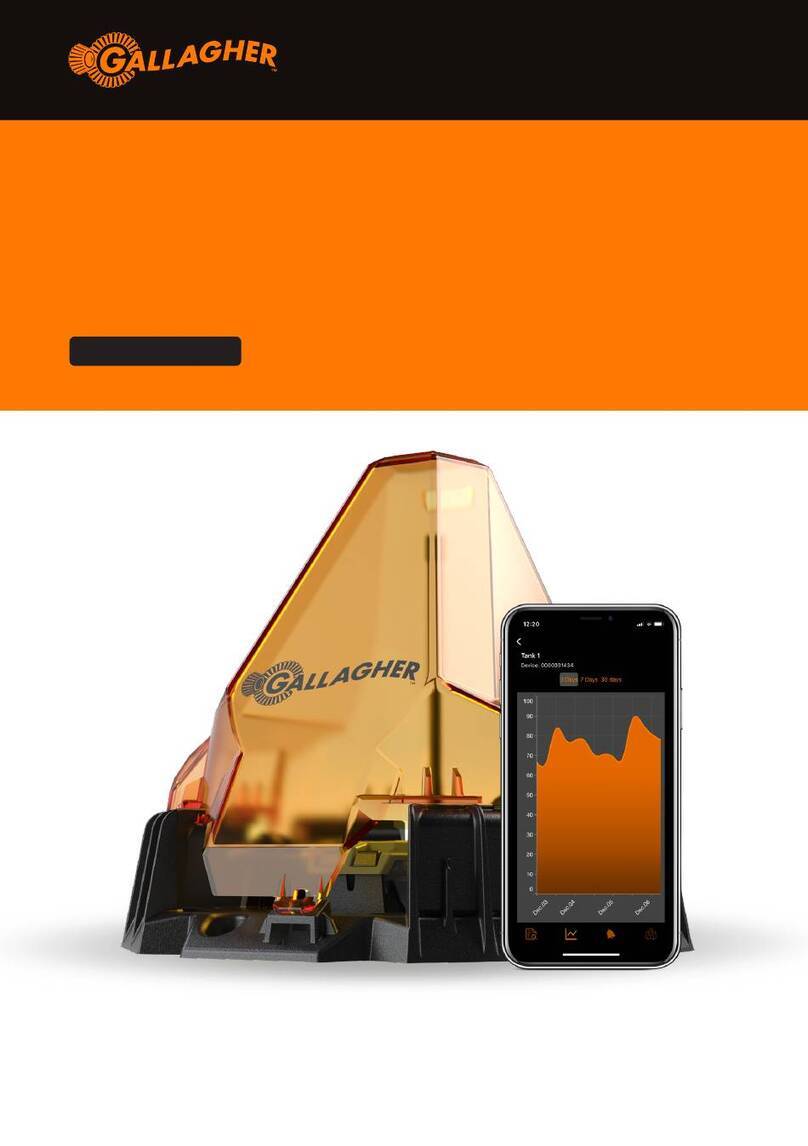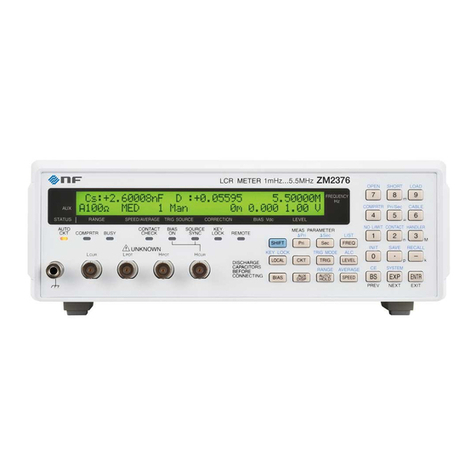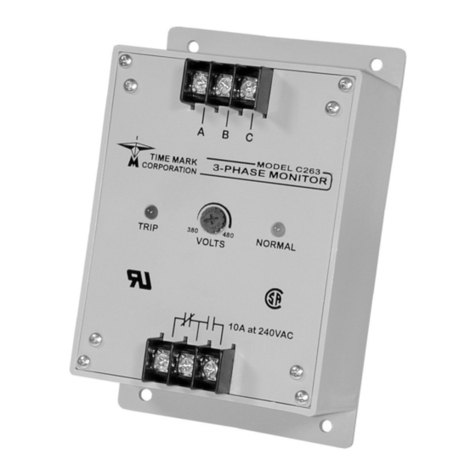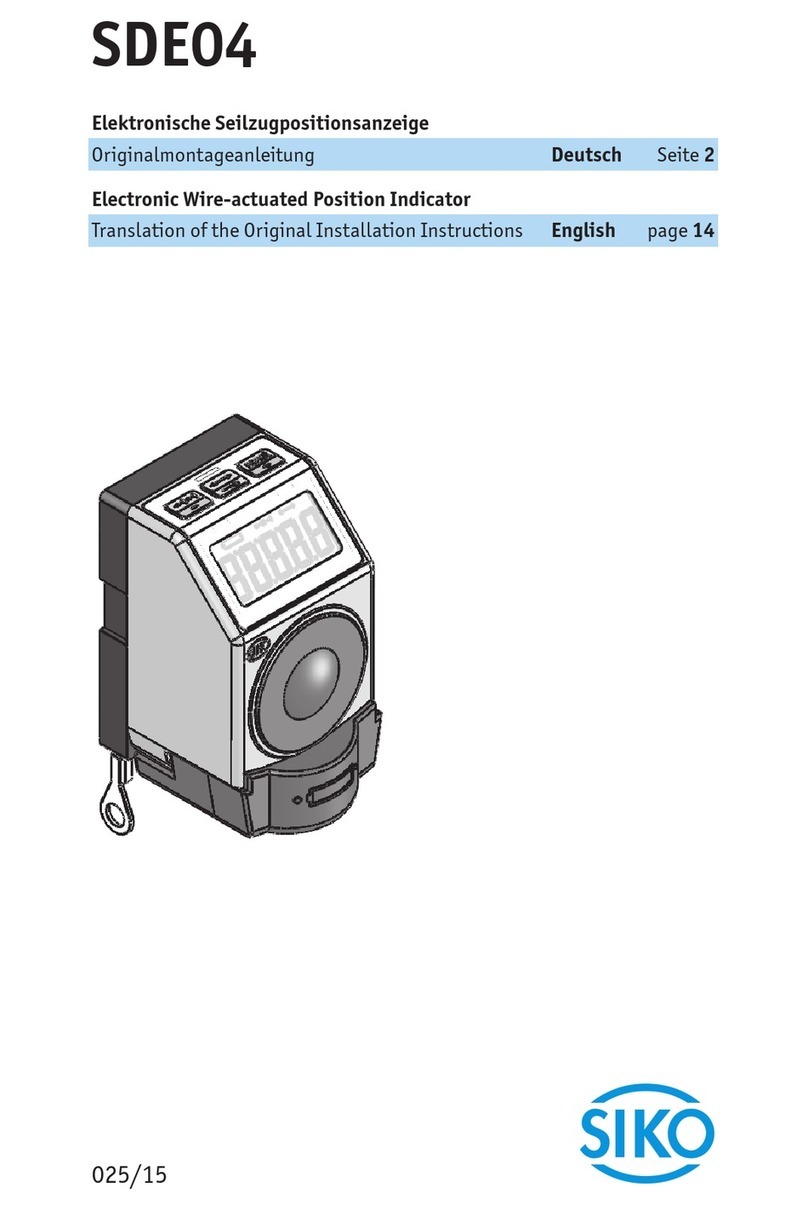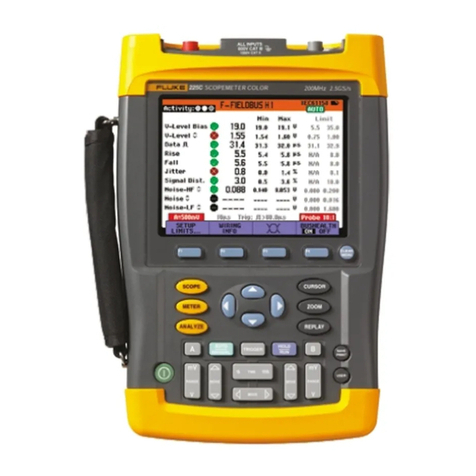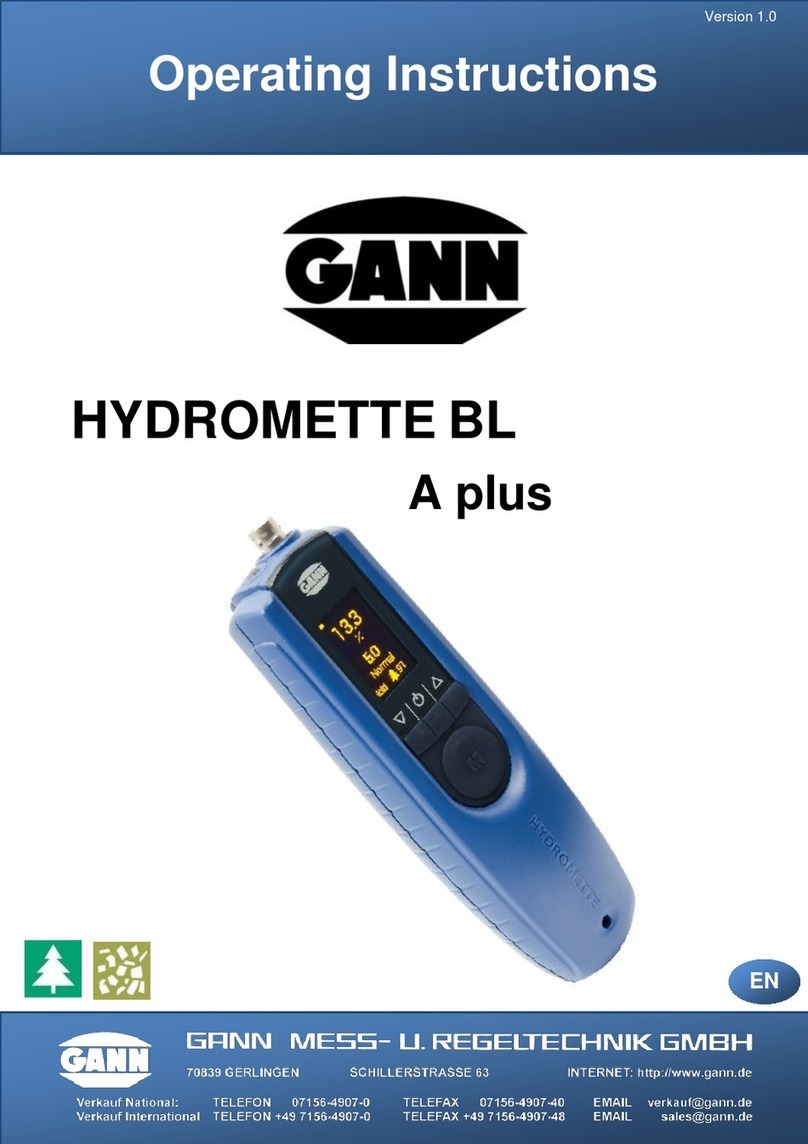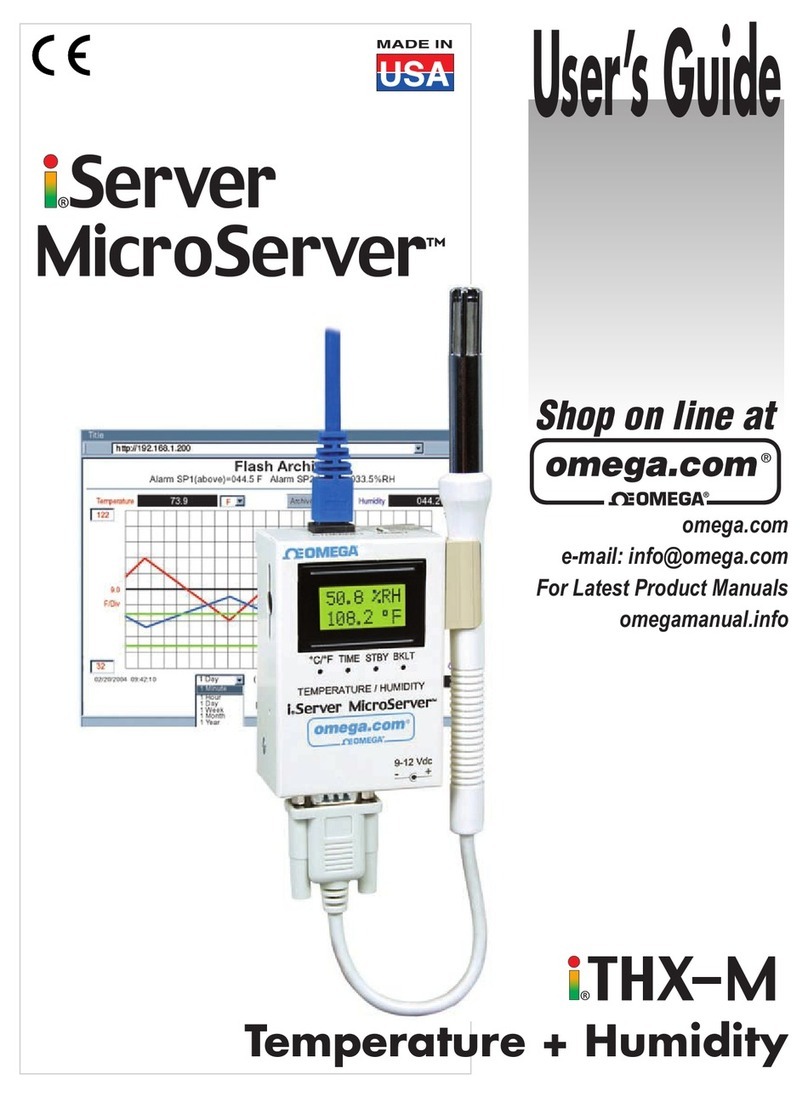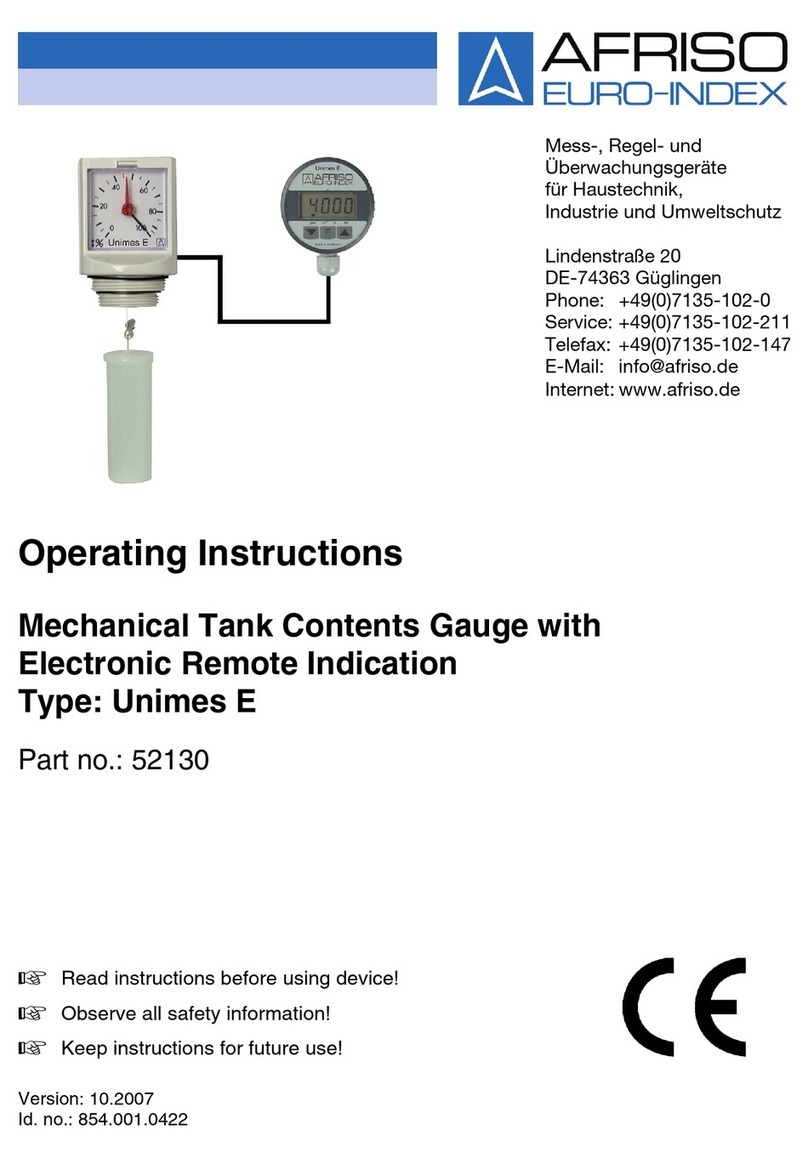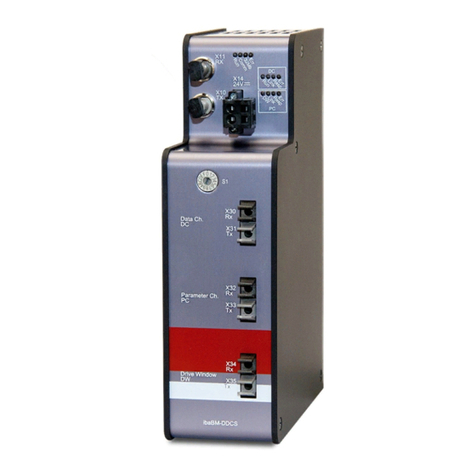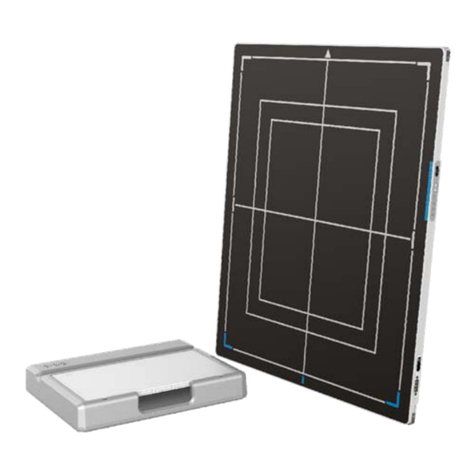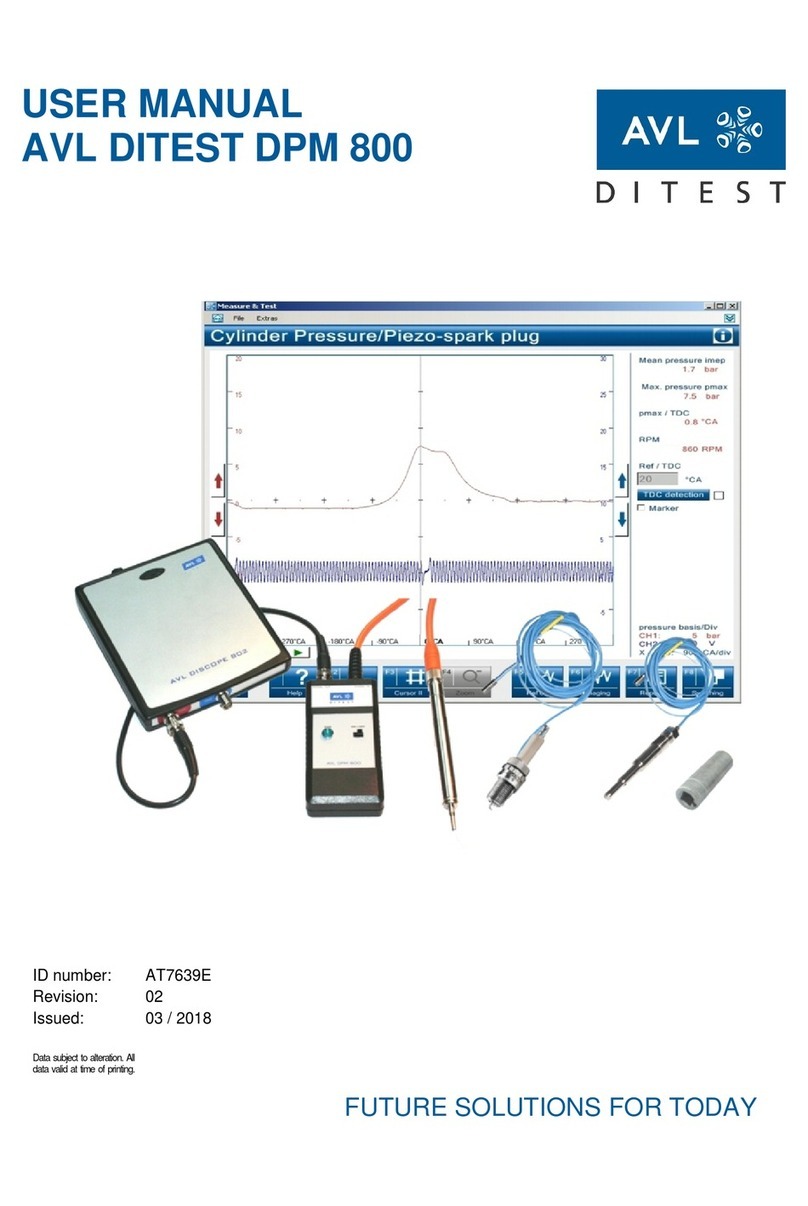INSTROTECH 4003 User manual

Model 4003 Temperature Indicator
Operating Manual for Model


Cleaning
Do not clean the instrument while the instrument is on.
Harsh abrasives, solvents, scouring cleaners and alkaline
cleaning solutions, such as washing soda, should not be
used especially on the display window. The outside of the
instrument may be wiped down with a slightly damp clean
cloth (lightly moistened with water only).
Under no circumstances should you attempt to wipe the
inside of the instrument.
Safety
This equipment is supplied by a mains voltage which can
cause an electric shock injury. Before removing the circuit
board from its housing, switch the instrument off, isolate it
from the mains power supply and make sure that it cannot
be connected inadvertently by other persons.
If the circuit board is removed from its housing, do not
apply power to the instrument unless specifically instructed
to do so in these instructions. When working on live
equipment, exercise great care, use insulated tools and test
equipment, and do not work alone.
When fitting option boards, always put the circuit boards
back in the housing with the back-plate securely fastened
before powering up the instrument.
When handling circuit boards, ensure that full anti-static
precautions are observed.
Replace external mains fuse with one of an equivalent type.
Contents
See last four pages for details of options fitted / available
Introduction ....................................................................... Page 4
Electrical specifications ..................................................... Page 4
Input ranges ...................................................................... Page 5
Programmable specifications ............................................ Page 5
Power supply .....................................................................Page 5
Other specifications ...........................................................Page 5
Installation (panel cutout) .................................................. Page 6
Installation (fastening) ....................................................... Page 6
Display & keypad (during normal display mode) ...............Page 6
Display & keypad (during programming mode) .................Page 6
Connections & links ...........................................................Page 6
Power supply links ............................................................ Page 7
Programming chart ............................................................Page 8
Display codes explained ................................................... Page 9
Programming example ...................................................... Page 10
Asciibus protocol ............................................................... Page 11
Option 3001-P / M, 3002, 3003, 3004................................ Page 12
Option 3004P / M, 3006,3009, 3010.................................. Page 13
Option 3012, 3013, 3017-P,3017-M.................................. Page 14
Option 3018-P / M, 3025, 3028.......................................... Page 15
Diagram “P” .......................................................................Page 16
Diagram “M” ...................................................................... Page 16
Declaration of conformity .................................................. Page 16
Guarantee ......................................................................... Page 16
Page 3

Electrical Specifications
Thermocouple input accuracy : 0.5°C, or 1 count (Note 1)
RTD input accuracy : 0.3°C, or 1 count
Cold junction accuracy : 0.5°C after 30 minutes
Internal resolution : 20000 counts (bi-polar)
Temperature coefficient : 20 ppm / °C typical
Conversion & settling time : 1 second
Operating temperature range : -10 to +50°C
Storage temperature range : -40 to +80°C
Humidity : < 85% non-condensing
Warm-up time : None required
Electro-mechanical relays : 250V AC, 30V DC, 2A, PF=1
Solid state relays : 400V AC/DC, 0.5A, PF=1
Analog output accuracy : 0.1% of full scale, 12 bits
Current analog output load : 500 W maximum
Voltage analog output load : 1 kW minimum
Memory retention : Full non-volatile operation
Option 3006 isolation rating : 1500 V
Declaration of conformity : See last page
Introduction
The Model 4003, 4 digit (9999) LED Universal Temperature
Indicator / Controller is used in applications where temperature
needs to be displayed & controlled.
This DIN 48x96, high accuracy, high-quality panel meter is
designed for accurate measurement & display (in °C, °F or K) of
temperature from thermocouples of Type J, K, N, R, S, T, W5 &
from RTDs such as PT100. Ni100 RTD is available as an option as
well as other thermocouple types. The thermocouple & RTD
signals are accurately linearised by the internal micro-controller.
Options include programmable analog output, 1, 2, 3, or 4 alarm
setpoints, peak / valley hold, RS232/485 communications & more.
The analog output is rangeable from the front pushbuttons.
The instrument meets European Community EMC directive
89/336/EEC and Low Voltage directive 72/23/EEC.
The instrument is designed for non-grounded thermocouple
probes only.
Page 4
Note 1: Overall accuracy is dependent on the thermocouple type. The table below lists the designated minimum standard error of
some thermocouple types:
Type: J K R S T
Minimum Std Error: ±2.2C ±2.2C ±1.4C ±1.4C ±0.8C

Programmable Specifications
Standard
115 / 230 VAC ± 10%, link selectable, 50/60Hz, 5VA typ
Optional
10 - 30VDC isolated power supply (Option 3008), 5VA typ
95V-265V AC/DC isolated power supply (Option 3010), 5VA typ
8 - 30VDC non-isolated (Option 3028), 5VA typ
Power Supply
Thermocouple type : J, K, N, S, R, T-, T+, W5
RTD type : PT100
Optional RTD types : Ni100, PT500, PT1000
Display : °C, °F or Kelvin (absolute temperature)
Broken TC protection : Selectable high or low
Broken RTD protection : Selectable high or low
Options :
Analog output zero & span : -1999 to 9999
Alarm setpoint values : -1999 to 9999
Alarm hysteresis : 0 to 255 (default 1)
Alarm delay : 0 to 255 seconds (default 0)
Alarm relay settings : Selectable HIGH or LOW alarm
Alarm relay state : Selectable NO or NC
Unit address : 1 to 127
Baud rate : 2400, 4800, 9600, 19200
Other Specifications
DIN 48 x 96 housing, 147mm depth
Industrial strength single piece housing
Housing is flame retardant ABS plastic that meets UL94 V-0
Circuit board is flame retardant material that meets UL94 V-0
Front facia rating : IP65 (with o-ring seal supplied as standard)
Input Ranges
The temperature probes are accurately linearised in the
following temperature ranges:
Type J : -25°C to +900°C
Type K : -25°C to +1275°C
Type N : +200°C to +1200°C
Type S : +625°C to +1750°C
Type R : +625°C to +1750°C
Type T- : -235°C to +25°C
Type T+ : -35.0°C to 330.0°C
Type W5 : +1150°C to +2050°C
PT100 : -165.0°C to +600.0°C (max 999.9°F)
Ni100 (optional) : -60.0°C to +235.0°C
PT500 (optional) : -165.0°C to +600.0°C (max 999.9°F)
PT1000 (optional) : -165.0°C to +600.0°C (max 999.9°F)
TC resolution : 1°C (Type T+ is 0.1°C)
RTD resolution : 0.1°C
Page 5

Fastening
The supplied fastening
clips may be fitted on
the side or the top /
bottom of the housing.
Ensure that the clip &
screw is mounted as
shown here.
Caution : Do not
overtighen the screws.
Min
12
45
92
Installation
To gain access to the
circuit boards, switch
power off and remove
terminals from the
back of the housing.
Observe safety
precautions. Use a
screwdriver to clip the
back-plate off.
During programming mode Display & Keypad
147
Panel Cutout
Installation
48
96
Enter
Programming menu
Move to next digit
Increment digit / change selection
Alarm LEDs
(illuminated whenever
relays are energised)
48
96
2 3 41
°F
Reset peak value (option 3012 only)
Print on demand (comms option only)
Show normal value (option 3012 only)
Show peak / valley hold value
(option 3012 only)
2 3 41
°F
All dimensions in mm
During normal display mode Display & Keypad
Page 6
O-ring sealing
gasket supplied
as standard
DIN 1/8 cutout
Min
12

Analog
output
option
(see
links
on J5)
RS232/
RS485
option
(use
pin 5 for
RS232
GND)
Alarm 1
Alarm 2
Alarm com
-
+
1. GND
3. RTD
4. RTD
7. +D (Rx)
5. -An out
2. T.C.
8. - D (Tx)
9. Reset
10
6. +An out
Neut (+)
11
12
Live (-)
Circuit board
J5
Link here for
voltage output
Alarm connections
for 3001/4-P only.
Solid state relays,
400V AC/DC,
0.5 A max, PF=1
Connections & Links
Linked for
current output
+
-
T.C.
RTD
For 230V
operation
For 115V
operation
DC supply
AC supply
-
+
N L
J2
Neut (+)
Power
supply
selector
Live (-)
J2 link positions do not matter for DC supply
or for Option 3008 or Option 3010.
AC supply
-
+
N L
J2
Neut (+)
Power
supply
selector
Live (-)
DC supply
Power Supply Links
Thermocouple
or
RTD input
Page 7
External peak / valley hold
reset (option 3012)
OR
Display hold function (option 3026)
Interposing relays
recommended for
heavy duty applications

RS485 / 232
only (Option
3002 / 3013)
, ,
, ,
, , , ,
, , , , ,
, , , , , , , , , ,
, ,
,
, ,
,
, , ,
,
READ ME FIRST !
,
,
, , for menu
(Similarly for alarm 2, 3 & 4)
“END”. Instrument returns to normal display mode.
to accept
new value
, ,, , ,,
Analog output
only (Option
3003 / 3007)
Alarms /
setpoints /
only (Option
3001/4/17/18)
Keypad lock
only
(Option 3025)
START
HERE
Programming Chart
(Similarly for alarm 2, 3 & 4)
Alarms /
setpoints /
only (Option
3001/4/17/18)
,,
,, , ,, ,
Peak / Valley
hold only
(option 3012)
, ,
, ,
,
,,
, ,, ,
, ,
, , , ,, ,, ,
Page 8
Note 1 : This programming chart is a simplified flowchart for users that have previous experience with this instrument. A programming example is
available in the next few pages to assist new users in understanding this programming chart.
Note 2 : Because this instrument has many options, all possible option menus are shown. Options that are not ordered will not appear in the
programming sequence.
Note 3 : Configuring this instrument requires two steps. (A) Select analog output (option) links (page 6). (B) Program the instrument with this chart.
Note 4 : To enter programming mode, press the menu key for a few seconds (unless the optional keypad lock has been set). Programming mode timeout
is about 20 seconds. If no key is pressed for 20 seconds during programming, the instrument returns to normal display mode.
Note 5 : The selection of the display engineering units (°C, °F, or K) does not automatically change the alarm setpoint units, analog output range etc. If

Hardware overrange. Reduce input signal to reduce saturation.
Type K thermocouple input
Type S thermocouple input
Type R thermocouple input
Type T positive thermocouple input
Broken thermocouple protection, read high or low
Open / short circuit RTD protection, read high or low
Output selection (0-10V, 0-20mA, 4-20mA)
Analog output menu
Protocol selection. On = AsciiBus. Off = DigiBus.
Process overscale. Input has exceeded full scale value. / Display test mode.
Thermocouple input selection menu
PT100 RTD input selection menu (this menu is also used for PT500 and PT1000 input options)
Nickel 100 RTD input selection menu (this menu will appear in place of the “P100” menu if ordered)
Input selection menu
Output zero selection
Output full scale selection
Unit address (default 0)
Display Codes Explained
1st, 2nd, 3rd, 4th setpoint value
Alarm configuration menu (shown for 1st alarm only)
1st alarm setpoint select HIGH / LOW alarm
1st alarm setpoint normally OPEN / CLOSED contact
1st alarm setpoint hysteresis
1st alarm setpoint delay
Communications menu (RS232 / RS485)
Peak OR valley hold. “off” = peak. “on” = valley
Available baud rate values
Degrees celcius selection for display
Type W5 thermocouple input
Absolute / Kelvin temperature selection for display
Reserved for future use
Type T negative thermocouple input
Please Note :
Display screens shown in black
are to indicate the beginning of
sub-menus.
Peak / valley hold option turned off or on
Option menu for Auto-zero feature and Peak / Valley Hold feature
Keypad lock security level. Level 0 = none,
Level 1 = alarm value changes, Level 2 = full
Keypad lock security menu. See Option 3025 for more information
Type N thermocouple input
Type J thermocouple input
Degrees farenheit selection for display
Page 9
Please Note :
If the front keypad has been
locked, then the word “PASS” will
appear. See option 3025 for more
information.

Remember, the symbols on the keypad have the following
definitions during programming.
Press “Menu” for
3 seconds
Next Menu
Item Increment digit Next Digit Enter /
Accept value
Press “Next digit” to
amend the next digit
Press “Increment digit”
to increase value
Press “Enter” to see
Alarm / Trip 1 value.
Amend the other digits in the same way until the desired trip
value is entered.
The entire programming menu operates in a manner
similar to the example described above.
Press “Menu” to
proceed to next
trip value.
Press “Enter” to accept
Alarm 1 value.
Setting Up Alarm Values (Option)
Programming Example
Use the same menu steps above to change trip levels
for trip 2, 3 and 4.
Page 10

Page 11
IGNORE THIS PAGE unless communications option has been ordered. When the RS232 (option 3013) or RS485 (option 3002) is
ordered, two protocols are made available, namely ASCIIbus & DIGIbus protocols. DIGIbus is the default protocol which is used for
the calibration and configuration of the instruments, and whenever the instrument is connected to master-slave systems. DIGIbus
protocol is therefore used in complex bus systems, and is NOT described here. Please contact factory for the DIGIbus protocol.
ASCIIbus, which is described here, is much easier to use as it can easily interface to third party systems with very little engineering
work required. It is a purely ASCII based (7 bit) protocol. The protocol is essentially designed for one way communications
(instrument to PC). Under the "Conn" (connection) programming menu, ASCIIbus is enabled by selecting "ASCI" to "ON". If "OFF" is
selected, the DIGIbus protocol will be active. Although designed for one way communications only, the ASCIIbus protocol contains an
address. The address range is "00" to "99".
Using address "00" : If this address is selected, the instrument will only transmit data on demand by either momentarily pressing the
'menu' key, or by transmitting a byte (any ASCII character) to the DPM. This mode is useful for interfacing to printers. In addition, field
' A A ' will contain the ASCII character "blank/space". Field ' P ' will also contain the ASCII character "blank/space".
Using address "01" to "99". If any of these addresses are used, the meter continuously transmits information at approximately 5 times
a second.
The data format string output from the indicator is (7 bit ASCII code is used):
Line Settings : 7 Data Bits, 1 Parity bit, Odd Parity, 1 Stop Bit.
Baud Rate : Selectable 2400, 4800, 9600, 19200.
Data Bits : Numerical ASCII characters : 0, 1, 2, 3, 4, 5, 6, 7, 8, 9
Other ASCII characters : #, blank/space, +, -, CR, LF
Protocol format is : # A A S D D D D D D D D P CR LF
where : # = indicates start of message
: A A = Instrument address. ASCII 00 to 99. 00 is default.
: S = sign (polarity) ( ASCII "+" or "-" ).
: D = data bits (data for 8 numerals). See Note (1).
: P = decimal point position. ASCII 0 to 8.
: CR = ASCII carriage return.
: LF = ASCII line feed.
The output will follow the display reading. This
means that if the peak-hold option has been
ordered and activated, the communications output
will peak-hold as well.
Note 1 : This protocol allows for future expansion.
Therefore if Model 4001 is used for example, the
first four digit data will contain the ASCII character
"blank/space" and the last four digits will contain
the display reading. Similarly, if the Model 5001 is
used for example, the first 2 digit data will contain
the ASCII character "blank/space" and the last six
digits will contain the display reading.
Asciibus Protocol (for Option 3002 / 3013)Communications

This option is similar to Option 3001-P but with a single alarm only. See page 7 for connection details. Wire for AL1 only.
See page 7 for connection details.
See page 7 for connection details. Wire for AL1 & AL2 only.
See page 7 for connection details. Select DIGIbus or ASCIIbus protocol from the program menu. See additional protocol documents.
One Setpoint Alarm (Solid State Relay)Option 3004-P
0 - 20mA / 4 - 20mA / 0 -10V Analogue Output OptionOption 3003
RS485 Serial Interface OptionOption 3002
Two Setpoint Alarms (Electro-Mechanical Relays)Option 3001-M
Two Setpoint Alarms (Solid State Relays)Option 3001-P
This option provides two alarm setpoints with electro-mechanical relays. This option board slots into the upper slot of the panel meter
box. The upper terminals are clearly numbered 13-28 to differentiate them from the lower terminals. Both normally open and normally
closed contacts are provides with each relay.The relays are rated at 250VAC / 30VDC @ 2A. Visual LED alarm indication is provided
on the panel meter front. For connection wiring details, see diagram “M” on page 16. Connect wires for AL1 & AL2 only.
Page 12

This option is similar to Option 3001-M but with one alarm setpoint only. See diagram “M” on page 16 for connections. Wire AL1 only.
One Setpoint Alarm (Electro-Mechanical Relay)Option 3004-M
This is ordered with option 3002, 3003, 3007 or 3013. It provides a minimum of 1500V isolation between input and output signal.
Wiring connections are different for these isolated options. Use diagram “P” or diagram “M” on page 16 for wiring connections.
Isolated Options (Analogue Output / RS232 / RS485)Option 3006
Page 13
This power supply option provides 8 - 30VDC supply isolation. See page 7 for connection details.
Galvanic Isolation (8 - 30VDC Supply) OptionOption 3008
Parallel BCD Output OptionOption 3009
This option is supplied as an additional slot in card in the top part of the instrument housing. See additional documentation.
This options allows the instrument to operate from a wide range of AC & DC power supplies. The supply connections are on page 7.
95V-265V AC / DC Power Supply OptionOption 3010

This option displays and holds the max or min value (not both) of an input signal. This option is activated in the programming menu
“Opt” by selecting whether “Hold” should be “On” or “Off”, and selecting valley (”valy” = “On”) or peak (”valy” = “Off”) mode.
To show peak / valley value, press the “up” arrow for 3 seconds. To show normal display value, press the “side” arrow key for 3
seconds. To reset the peak / valley hold value, press the “star” key for 3 seconds, or use an external potential free contact (see page
7 for connection details). If analog output option is fitted, the output will hold as well.
Peak Or Valley (Max or Min) Hold OptionOption 3012
See the additional pages supplied for protocol details & page 7 for connection details. Ensure that maximum cable length from
instrument to PC is less than 15 metres.
RS232 Serial Interface OptionOption 3013
Three Alarm Setpoints (Solid State Relays)
Option 3017-P
This option provides three alarm setpoints with solid state relays. This option board slots into the upper slot of the panel meter box.
The upper terminals are clearly numbered 13-28 to differentiate them from the lower terminals. Only normally open contacts are
provided, which means that should the contacts be closed and the power fails, they will revert to a normally open condition. The
relays are rated at 400V AC /DC @ 0.5A. Visual LED alarm indication is provided on the panel meter front. For connection wiring
details, see diagram “P” on page 16. Connect wires for AL1, AL2 & AL3 only.
Page 14
Three Alarm Setpoints (Electro-Mechanical Relays)Option 3017-M
This option provides three alarm setpoints with electro-mechanical relays. This option board slots into the upper slot of the panel
meter box. The upper terminals are clearly numbered 13-28 to differentiate them from the lower terminals. Both normally open and
normally closed contacts are provides with each relay.The relays are rated at 250VAC / 30VDC @ 2A. Visual LED alarm indication is
provided on the panel meter front. For connection wiring details, see diagram “M” on page 16. Connect wires for AL1, AL2 & AL3 only.

This option is similar to option 3017-P, but contains four relays (see option 3017-P). For connection wiring details, see diagram “P” on
page 16. Connect wires for AL1, AL2, AL3 & AL4.
Four Alarm Setpoints (Solid State Relays)Option 3018-P
This option is similar to option 3017-M, but contains four relays (see option 3017-M). For connection wiring details, see diagram “M”
on page 16. Connect wires for AL1, AL2, AL3 & AL4.
Four Alarm Setpoints (Electro-Mechanical Relays)Option 3018-M
Keypad Lock OptionOption 3025
Page 15
The keypad lock option is used to prevent un-authorised access to the programming menu. When this option is ordered, a new sub-
menu called “CODE” appears at the end of the programming sequence. See programming page 8.
Three levels of keypad lockout are available: Level 0 - Full access to programming menu. Level 1 - User only has access to alarm
setpoint values. Level 2 - Total programming menu lockout.
If this option is ordered, the factory default is “Lev 0”. If the keypad has been locked with either level 1 or 2, then the word “PASS” will
appear on the display if the user attempts to enter programming mode. Pressing the menu key will return the instrument to normal
display mode. However, if the user wishes to enter the programming menu, then when the word “PASS” appears, press in
succession, 1 second apart, all four keys from right to left.
Non isolated(8 - 30V Supply) OptionOption 3028
This option provides an 8 to 30VDC non-isolated power supply. See page 7 for connection details.

Diagram “P”
+ Voltage output
- Output
+ Current output
NO
AL4
NCNO
AL3
NCNO
AL2
NC
AL1
NC NO
Diagram “M”
Universal Temperature Indicator / Controller
Lower Terminals
(Mother board)
Upper Terminals
(Option boards)
19 20 25 26 27 2813 14 15 16 17 18 21 22 23 24
N(+) L(-)
1 2 3 4 5 6 7 8 9 10 11 12
AL2 AL3
AL1 AL4
+ Voltage output
- Output
+D (Rx)
-D (Tx)
Comms GND
+ Current output
NO NO NONO
Lower Terminals
(Mother board)
Upper Terminals
(Option boards)
19 20 25 26 27 2813 14 15 16 17 18 21 22 23 24
N(+) L(-)
1 2 3 4 5 6 7 8 9 10 11 12
Declaration of Conformity
Manufacturer : DPM
Type : 4003
Options : 3000 to 3028
Corresponds to the requirements of the following EC directives:
EMC directive : 89/336/EEC
Low voltage directive : 73/23/EEC
The applicable harmonised standards are : EN 50081-1
: EN 50082-1
: EN 61010
The manufacturer undertakes to replace without charge all
defective equipment which is returned to it (transportation costs
prepaid) during the period of guarantee, provided there is no
evidence that the equipment has been abused or mishandled in any
way.
The manufacturer reserves the right to alter any specification
without notice.
Guarantee
Page 16
This product is guaranteed against faulty workmanship or defective
material, for a period of 2 (two) years from date of delivery.
